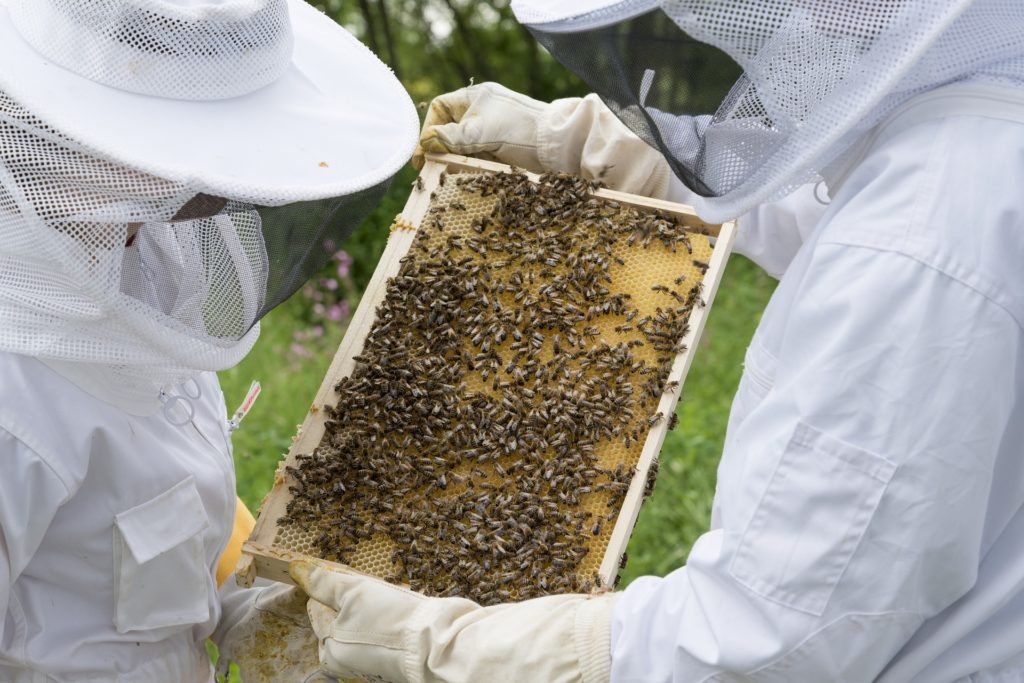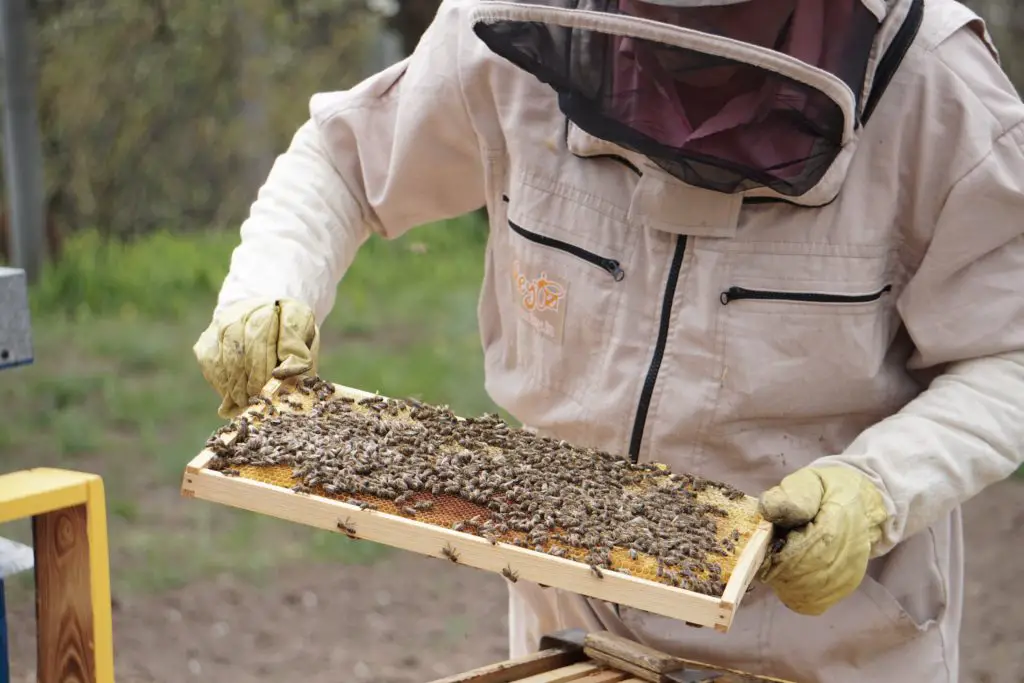Affiliate Disclaimer - As an Amazon Associate I earn from qualifying purchases.
It supports the website. So, Thank you
The queen is perhaps one of the most important bees in your hive but if you’ve ever tried to spot her then you might have realized that they’re not always as obvious as people think.
While you might expect to see a large, plump bee that’s unmistakable, that isn’t always the case. In fact, in some cases, the queens are so well camouflaged it can be like playing an extremely hard version of ‘Where’s Waldo.’
Of course, as a beekeeper, you’re going to want to be able to recognize your queen. If you haven’t been able to up until now, don’t kick yourself as even some veteran apiarists find it hard at times. So what are you looking for? What do queen bees look like?
A queen bee is typically bigger than the other members of the hive. She may also have slightly shorter wings and longer legs compared to the workers.
In this guide, I’ll be helping you locate your queen and explaining exactly what it is you need to be looking out for.
Table of Contents
What Is A Queen Bee?
The term queen bee is given to the adult, mated females that live within a colony. However, there’s only ever one queen in a colony and, as a beekeeper, it’s really important that you understand her role.
Bee colonies rely on teamwork with every member having his or her own job. There are tons of worker bees and while there may only be one queen, the colony would fail without her. It’s her job to keep the population going and lay as many eggs as possible.
Unlike the other female members of the hive, the queen has far more developed ovaries and releases chemicals that cause the drones to mate with her. She will also release chemicals to ensure the unity of the colony.
How To Identify Your Queen
When you look into your beehive, you’ll be confronted with a hum of activity and a serious number of winged friends. Looking at this mass of bees will probably have you scratching your head and wondering which one is the queen.
The good news is that you can, for the most part, tell a queen from the rest of the colony due to her appearance. Moreover, there may be differences in the way she moves and behaves. So let’s take a closer look.

Appearance
One of the most distinguishing features of the queen bee is that she is a lot larger than the other members of the hive. Typically speaking, these bees can grow up to twice as large and are usually around 2 cm in length as well as being a lot plumper.
However, the size of the queen isn’t the most reliable way of spotting her within the hive as some other members could have grown to be relatively large and this makes it easy to make a mistake when identifying.
Instead, I’d recommend taking a look at the coloration of the bees. The queen will have much more uniformity across the abdomen and there will be a black dot located on the thorax. You’ll notice that the back of the queen is a lot shinier and deeper black in color as well as being bald.
Where coloration is concerned, queens can vary greatly. Some may be yellow or brown whereas others might have a black or grayish hue. Therefore, the overall color of the queen shouldn’t be used as a reliable method of identification. Moreover, bees will raise a new queen when necessary and this bee may be a totally different color from the previous queen.
Also, take a look at the stinger as in queens, this will be smooth as opposed to the barbed design we see on worker bees.
Movement
If you take a few moments to look at how your colony is moving, this can help you to pick out the queen. It’s not uncommon for the queen to be in the center of surrounding worker bees who are trying to protect her. When this happens, you will notice that the workers form a flower-like shape around the queen which is pretty unmistakable. Each bee will be facing inwards when in this formation.
You might also wish to take a look at how the queen herself moves. Compared to other members of the hive, she’ll appear to be moving with a greater sense of purpose and she’ll normally move a lot faster than the workers.
When she’s moving around, the worker bees will create a path for her so you’ll see a clear break in the pattern of the hive which makes spotting the queen a lot less tricky.
Behavior And Location
Since the main job of the queen bee is to lay eggs, you’re more likely to find her in the nursery although this may not always be the case.
In some rare instances, the queen may be found sitting on frames of honey so even though it’s less likely, it is worth checking if you’re having problems locating her.
However, when you are looking for the queen, time is of the essence. These bees will not hang around if there is a threat of any sort of danger and will often hide in a corner of the hive if it is left open for too long.
Marking The Queen
One of the questions I hear a lot from new beekeepers is whether they should mark their queen. There are pros and cons to this although there’s really no right or wrong answer, but let’s break it down a little.
First things first, know that marking your queen certainly isn’t essential. But if you do then identifying her becomes so much easier and this is even truer once your hive starts to really grow.
If your queen is trying to hide when you have the hive open, marking her will make her a lot easier to spot. Plus, you can even color code the marking so you can keep track of the queens’ year of birth.
On the other hand, there are beekeepers that are completely against the idea of marking the queen. The reason for this is that it doesn’t give you the practice you need to develop the ability to just spot the queen. Of course, this does take time but if you really want to get deeply into beekeeping, learning these skills is important.

How To Inspect Your Hive When Looking For The Queen
It’s no good just going in and opening your hive to spot the queen. As I’ve mentioned, the longer you leave the hive open, the more chance there is of the queen scurrying off into a corner to keep safe.
It’s also really important to use as little smoke as possible when trying to locate the queen. If you use too much, this will also cause her to go and hide.
When looking at the frames, make sure you do a thorough job. Take a brooding frame at a time and check one side and then the other. It can be very difficult to scan an entire frame in one go so break it down and scan a third or even a quarter at a time.
I’d also recommend spending some time looking at the larger drones in your hive. It’s common for them to have rounder backsides and big eyes which some people mistake for the queen.
Replacing A Queen
A queen bee will generally live for around two years, sometimes a little longer. However, she might not be an effective queen for her entire life and it’s not uncommon for beekeepers to replace her after a couple of seasons as this will ensure the most productive and efficient hive.
Of course, if the current queen is alive, you might be wondering whether there’s any need to replace her. But you have to consider that her ability to lay eggs will dwindle over the course of time. When this happens, there are fewer bees in the colony and less honey production.
One of the things I’d advise you to monitor is the egg-laying capacity of your queen. If you notice that this is slowing down with age then it’s a good time to think about replacing her to ensure that the hive continues to thrive.
Practice Makes Perfect
There are far too many people that go into beekeeping with the idea that this will be an easy hobby. But it’s not. In fact, beekeeping requires quite a lot of learning and it’s common to see first-year hives dying out and the apiarist having to start all over again.
So, it’s really important not to kick yourself if you don’t get your beekeeping skills down to a T in the first few weeks of owning your hive. In fact, it can take several years before you’re considered to be anything more than a novice and that’s OK; learning about your bees is all part of the fun.
But when it comes to identifying the queen, unless you mark her, you’ve got no other choice but to practice. The more you get to know your colony and the more you learn about bees in general, the easier it will become to spot her.
Final Thoughts
Have you ever opened your hive and seen all that activity only to wonder how on earth you’re expected to locate the queen? If you have then you’re not alone; a lot of new beekeepers ask what do queen bees look like?
The queen will normally be larger and have distinguishing features such as shorter wings, different coloration, and longer legs. But her appearance isn’t the only way you can locate her. How she moves, her behavior, and her location within the hive are all key giveaways.
Many beekeepers mark the queen, you can even buy a colony with a pre-marked queen, and this can make her super easy to spot. However, if you want to develop a keen eye for your bees then it’s worth taking the time to practice and eventually, you’ll be able to spot the queen without an issue.




